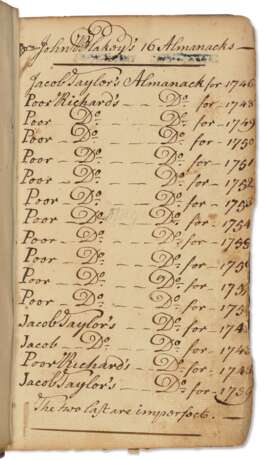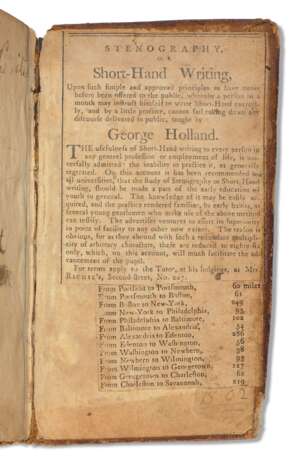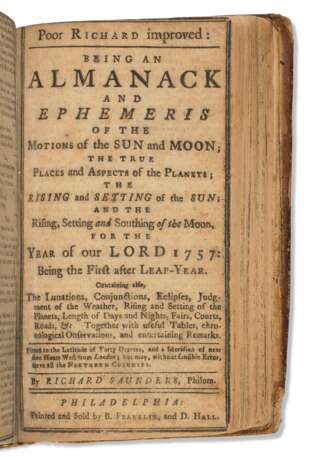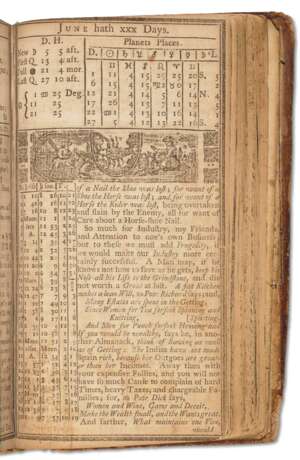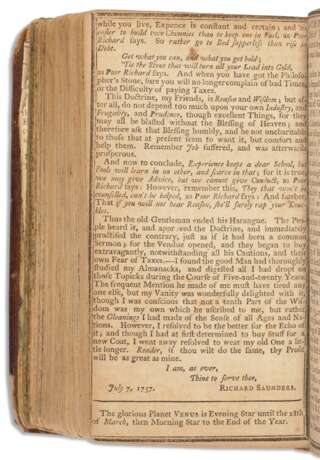ID 517654
Lot 8 | Poor Richard's Almanac: Unique Sammelband
Valeur estimée
$ 300 000 – 500 000
"Early to bed and early to rise
Makes a man healthy, wealthy and wise."
The first complete first edition of Benjamin Franklin's most famous work to appear at auction in almost thirty years, present in an extraordinary contemporary sammelband with eleven other of Franklin's Poor Richardalmanacs. The 1758 issue of Poor Richard's Almanac was the last in the series to be edited by Franklin himself and he used the occasion to gather together approximately 100 of his proverbs and maxims into one preface in the form of "the harangue of a wise old man to the people attending an auction." However the so-called "preface" in this issue is specially extended through each of the twelve calendar months plus an additional page at the end. All twenty-six preceding Poor Richard's are represented in this culminating work and the selected maxims are those focused on diligence, prudence and thrift. Under various titles such as The Way to Wealth and Father Abraham's Speech, this is the most widely reprinted and read of any of Franklin's works. It is fundamental to the legend of Franklin as our folksiest founding father and certainly a defining work of colonial Americana—even though few of the maxims were strictly speaking American originals. Although likely printed in an edition of over 10,000; extremely few copies survive intact. 10,000 was an average print run for the Poor Richard's in 1750s and this special 1758 issue was published about a month earlier than the others. There are 20 surviving copies identified by Miller. The last complete copy we trace at auction belonged to Bradley Martin and sold in 1990 and again in 1993. For a fascinating discussion of this work's bibliography see “Poor Richard Improved, 1758,” Founders Online, National Archives, https://founders.archives.gov/documents/Franklin/01-07-02-0146.
This copy is additionally extraordinary for its being collected into a sammelband in the 18th century. The flyleaves and several of the title-pages bear the ownership marks John Blakey (born circa 1730), who has also provided a contemporary manuscript table of contents. Few colonial Americans had the foresight to collect these almanacs and we trace at auction no other contemporary collections of Poor Richard's almanacs specifically, although individual issues are known to have appeared in collections of almanacs in general. There are an incredible eleven other Poor Richard's almanacs in this modest volume, ten of which are complete, and all of which are individually precious and printed and/or edited by Franklin himself.
Comprises: 1) TAYLOR, Jacob. An Almanack, and Ephemeris …for the Year 1746. Philadelphia: William Bradford, [1745.] (Title page detached and laid in.) 2) Poor Richard improved: Being an Almanack and Ephemeris … for the …Year, 1748. Philadelphia: B. Franklin, [1747.] 36 pp. “Middle Colonies” issue intended for local readership (the rarest of the issues located by Miller). Miller 419. 3) Poor Richard improved: Being an Almanack and Ephemeris …for the Year…1749. Philadelphia: B. Franklin and D. Hall, [1748.] 36 pp. Early issue with the Earth’s circumference given as “nigh 4000 miles” rather than 24,000—a printing fault of which Franklin poked fun in the preface to next year’s Almanac (present in this Sammelband) and which has here been corrected in early manuscript. It was the first Poor Richard printed under David Hall’s supervision, in partnership with Franklin. Miller 441. 4) Poor Richard improved: Being an Almanack and Ephemeris…for the Year…1750. Philadelphia: B. Franklin and D. Hall, [1749.] 36 pp. Early ownership inscriptions of both Thomas Leech and John Blakey on title (corner dampstain to last few leaves). Miller 469. 5) Poor Richard improved: Being an Almanack and Ephemeris …for the Year…1751. Philadelphia: B. Franklin and D. Hall, [1750.] 36 pp. (Last leaf of December torn.) Ownership signature of John Blakey. Miller 502. 6) Poor Richard improved: Being an Almanack and Ephemeris …for the Year…1752. Philadelphia: B. Franklin and D. Hall, [1751.] 36 pp. In this issue, Franklin discusses the history of the Christian calendar and reprints the Parliamentary Act of 1751 which altered the year 1752 by omitting 11 days in September and directed that the year begin on January 1 rather than March 25. (Corner chip to the first leaf March.) Miller 529. 7) Poor Richard improved: Being an Almanack and Ephemeris …for the Year…1753. Philadelphia: B. Franklin and D. Hall, [1752.] 36 pp. Miller 552. 8) Poor Richard improved: Being an Almanack and Ephemeris …for the Year…1754. Philadelphia: B. Franklin and D. Hall, [1753.] 36 pp. Miller 570. 9) Poor Richard improved: Being an Almanack and Ephemeris …for the Year…1755. Philadelphia: B. Franklin and D. Hall, [1754.] 36 pp. Miller 586. 10) Poor Richard improved: Being an Almanack and Ephemeris …for the Year…1756. Philadelphia: B. Franklin and D. Hall, [1755.] [36] pp. (Final two leaves are misbound at end of the Almanac for 1758.) Miller 608. 11) Poor Richard improved: Being an Almanack and Ephemeris …for the Year…1757. Philadelphia: B. Franklin and D. Hall, [1756.] 36 pp. Miller 635. 12) Poor Richard improved: Being an Almanack and Ephemeris …for the Year…1758. Philadelphia: B. Franklin and D. Hall, [1757.] 36 pp. The 26th Poor Richard, the final one to be known to have been authored by Benjamin Franklin, and containing “Way to Wealth.” Miller 657. 13) [Jacob Taylor’s Almanac for 1742.] (Lacking title-page.) 14) TAYLOR, Jacob. An Almanack, and Ephemeris …for the Year 1743. Philadelphia: William Bradford, [1742.] 15) Poor Richard, 1743. An Almanack for the Year of Christ 1743. Philadelphia: B. Franklin, [1742]. 18 pp only (of 24). Miller 281. 16) [Jacob Taylor’s Almanac for 1739.] (Lacking title-page.)
12mo (150 x 85mm). Sixteen almanacs bound together. Calendrical woodcuts and anatomical cuts. (Trimmed close with occasional shaving of letters, scattered minor dampstain, 3 almanacs defective, individal notes listed above, sold with all faults.) Near contemporary sheep (worn, endleaves loose, modern black ink on endleaf verso, front hinge repaired with duct tape.) Provenance: John Blakey, c.1730-1806, likely of Chester, PA (ownership signatures, manuscript index leaf itemizing all 16 almanacs and noting the imperfections of the last two, manuscript first person note that his other volume of almanacs he gave away to "young Nathan Sharples of Goshen," presumably Blakey's nephew Nathan Sharples, 1752-1837).
| Adresse de l'enchère |
CHRISTIE'S 20 Rockefeller Plaza 10020 New York Etats-Unis | ||||||||||||||
|---|---|---|---|---|---|---|---|---|---|---|---|---|---|---|---|
| Aperçu |
| ||||||||||||||
| Téléphone | +1 212 636 2000 | ||||||||||||||
| Fax | +1 212 636 4930 | ||||||||||||||
| Conditions d'utilisation | Conditions d'utilisation | ||||||||||||||
| transport |
Service postal Service de messagerie ramassage par vous-même | ||||||||||||||
| Modes de paiement |
Virement bancaire | ||||||||||||||
| Heures d'ouverture | Heures d'ouverture
|

